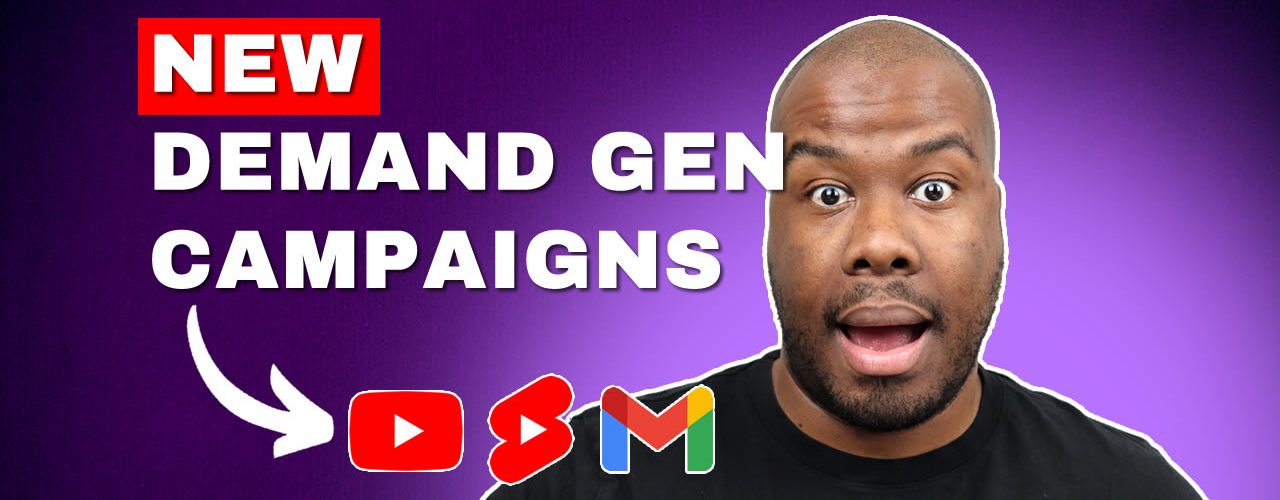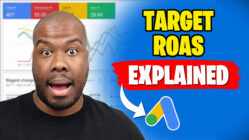Video Transcript
It doesn’t happen very often, but Google have actually released a new campaign type called a Demand Gen campaign. This new campaign type is set to replace discovery campaigns, and in today’s video I’m gonna walk you through exactly what the differences are between discovery campaigns and this new demand gen campaign type.
Whether or not your business should be using them in the future, and also when does all this happen? So let’s first start with discovery campaigns. And this campaign type allows advertisers to advertise across YouTube’s homepage, watch next on Gmail, and also in the discovery feed on Android devices. So if you’ve ever gone onto an Android device, like a phone or a tablet, There’s a feed in Google, in the Google app itself that shows you loads of relevant news stories and other bits and pieces that you can look at as a user that are tailored to your individual needs.
You can actually advertise there as well, and that is essentially all the inventory of a discovery campaign. I made a whole video covering discovery campaigns, including best practices and a full tutorial. I’ve linked that down below, but that gives you kind of an overview of what this campaign type actually is.
So how does a Demand Gen campaign differ from that original discovery campaign format? Well, firstly, there are a couple of new inventory placements within this campaign format that aren’t available in discovery campaigns, and one of the main ones is YouTube shorts. Now, of course, YouTube have been pushing shorts ever since TikTok started becoming massive.
Google thought they needed a short form content platform, so they started with shorts, and there’s a lot of opportunities to advertise there now, and particularly more so now. With this new Demand Gen campaign type, you can actually advertise in YouTube shorts. You can also advertise Instream on YouTube, which is a bit different to what you could do on the original discovery campaign where you pretty much had static placements.
This allows you to advertise in a more dynamic way, instream, when people are consuming content. So there are a couple of advantages already on this new campaign type in terms of number of placements available to you as an advertiser. There are other benefits as well available to you because when you actually go into Google Ads and start building this campaign type, you can actually see some really interesting previews of how the ads will look as you are building them, which gives you more context in what people are going to see when adver, when customers click your ads, whether or not they’re going to find them interesting.
You can get a good preview of what they’re going to look like, which I think. It’s pretty handy. But one of the main standout differences from a discovery campaign is the lookalike audience option. Now, lookalike audiences are essentially a way of expanding your targeting. So what happens is, From the activity across your campaigns and website, Google can find users who act like and behave like the users who are converting on your website.
So looking at those kind of behavioral signals of your best traffic and then expanding that reach outside of people who already know your. Site to people who’ve never discovered it before, but because those people who have never discovered it before shows similar signals to the people who actually like what you do, then that’s the idea of a lookalike campaign.
You could hopefully get more conversions by targeting those people. The degree to which Google can find people similar to your core audience. Is also controllable by you as well, because there is a slider where you can say you want a really narrow focus to really ask Google when they’re looking for people who behave like your existing audience and customers, to keep it very narrow, to find people that most closely match the people in your target audience.
Or you can expand it and go a bit further and get more volume through the campaign by expanding that audience to go, okay, these people are. Potentially like the people in my main core audience, but they only show some of the signals. So you can actually expand that to get more volume as well. So that’s a really interesting feature, being able to generate new traffic of people who could be interested in your services, but using lookalike audiences.
So, so far this all sounds really positive, but let’s take a step back and understand why Google. Have made this change. Why are they getting rid of discovery campaigns and why are they pushing this new Demand Gen campaign type? Well, there are two answers. There’s the Google answer and then there’s the real answer for argument’s sake.
Let’s start off with the Google answer first. The argument Google gives for this campaign type centers around polling data, they actually say, according to a Google Ipso survey, one in three consumers say they have purchased something on Google feeds, like Discover and Gmail, that they were not.
Originally shopping for. Furthermore, they go on to say 86% of Gen Z users agree that YouTube helps them discover new products they’re interested in. So Google is leading their argument with data to say, okay, this is how people are discovering new products. And of course, gen Z, the generation coming up that are gonna get increasingly more spending power, who potentially advertises seat as a core audience for the future.
These people are using Google’s inventory in terms of the non-direct search inventory, so things like YouTube and things like Discover and Gmail to find products they’re interested in. So Google, of course, have thought, how can we take advantage of this and bring a campaign type that works for advertisers to hit these audiences, which are key audiences.
I agree with Google there. However, my cynical take. Is that Google want to increase the sale of their ad inventory by adding shorts and additional YouTube placements to a discovery campaign and upgrading it. To what’s called a demand gen campaign. They can sell more ads. It’s as simple as that. And Google’s long-term goal is to maximize conversions and maximize the volume of conversions.
Meaning, of course, if you’re maximizing, they’re gonna sell more inventory. And one of the key things as well to look for is that Google aren’t as focused about the cost of those sales. A lot of the, the functions advertisers have, or shall I say, had. To control the cost of sale are being removed, but a lot of opportunities like this new campaign type are gonna maximize the overall market opportunity for advertisers.
So it can be good for some advertisers, but also quite negative for those looking for additional constraints as well. So ultimately, should your business be testing this new campaign type? Well, the answer is yes, of course. I mean, this is a new campaign type Google don’t do this very often. And if you are a business that’s spending significant amounts on Google already and you’ve maximized your search campaigns, maximized your shopping campaigns, and you’re kind of at that point of diminishing returns where you can’t spend any more money and you wanna expand your campaign types into some new inventory that you have never advertised on before.
Then this presents a good opportunity to do that. So I would always advocate to test this, but of course, make sure that you’ve hit the bottom of funnel first. If you haven’t maxed out your spend on search or shopping depending on your industry, then maximize that spend first before moving into this new territory where conversions happen a bit further up the funnel.
These are touch points and quite often branded. Touch points as well. So this isn’t necessarily going to convert as strongly as a search campaign. So when does all this happen? When do you get your hands on a demand gen campaign? Well, it’s already in beta right now, and if you’re not currently in the beta then you’ve probably missed it.
It’s too late for you. But the good news is in October of this year, all existing discovery campaigns will be upgraded. To a demand Gen campaign straight away. And the good news is as well, is that the data consistency will remain. So your campaign spend and data and performance data from your discovery campaign, when it goes over to a demand gen campaign, the data will remain in the campaign and be consistent.
So you can measure the before and after the upgrade point, and then by November of this year, Discovery campaigns will be gone, and you can only build a demand gen campaign, and that will be rolled out to all advertisers. So overall, this is an interesting proposition, but ultimately I wanna know what your thoughts are.
What do you think of this new campaign type? Will you be testing it out in your business? Let me know down below in the comments. I reply to pretty much every comment on new videos. Like this video if you like it. Don’t forget to subscribe. Don’t forget to head over to darren-taylor.com for support on your Google Ads campaigns and audits and more.
Head to my website for more information and I’ll see you guys on my next video..







